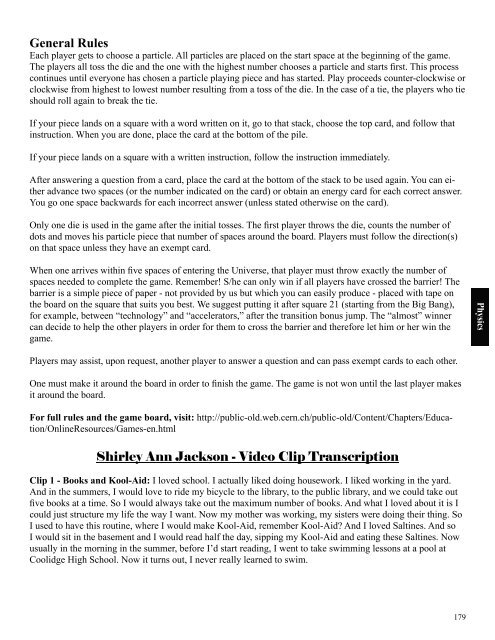ScienceMakers Toolkit Manual - The History Makers
ScienceMakers Toolkit Manual - The History Makers
ScienceMakers Toolkit Manual - The History Makers
Create successful ePaper yourself
Turn your PDF publications into a flip-book with our unique Google optimized e-Paper software.
General Rules<br />
Each player gets to choose a particle. All particles are placed on the start space at the beginning of the game.<br />
<strong>The</strong> players all toss the die and the one with the highest number chooses a particle and starts fi rst. This process<br />
continues until everyone has chosen a particle playing piece and has started. Play proceeds counter-clockwise or<br />
clockwise from highest to lowest number resulting from a toss of the die. In the case of a tie, the players who tie<br />
should roll again to break the tie.<br />
If your piece lands on a square with a word written on it, go to that stack, choose the top card, and follow that<br />
instruction. When you are done, place the card at the bottom of the pile.<br />
If your piece lands on a square with a written instruction, follow the instruction immediately.<br />
After answering a question from a card, place the card at the bottom of the stack to be used again. You can either<br />
advance two spaces (or the number indicated on the card) or obtain an energy card for each correct answer.<br />
You go one space backwards for each incorrect answer (unless stated otherwise on the card).<br />
Only one die is used in the game after the initial tosses. <strong>The</strong> fi rst player throws the die, counts the number of<br />
dots and moves his particle piece that number of spaces around the board. Players must follow the direction(s)<br />
on that space unless they have an exempt card.<br />
When one arrives within fi ve spaces of entering the Universe, that player must throw exactly the number of<br />
spaces needed to complete the game. Remember! S/he can only win if all players have crossed the barrier! <strong>The</strong><br />
barrier is a simple piece of paper - not provided by us but which you can easily produce - placed with tape on<br />
the board on the square that suits you best. We suggest putting it after square 21 (starting from the Big Bang),<br />
for example, between “technology” and “accelerators,” after the transition bonus jump. <strong>The</strong> “almost” winner<br />
can decide to help the other players in order for them to cross the barrier and therefore let him or her win the<br />
game.<br />
Players may assist, upon request, another player to answer a question and can pass exempt cards to each other.<br />
One must make it around the board in order to fi nish the game. <strong>The</strong> game is not won until the last player makes<br />
it around the board.<br />
For full rules and the game board, visit: http://public-old.web.cern.ch/public-old/Content/Chapters/Education/OnlineResources/Games-en.html<br />
Shirley Ann Jackson - Video Clip Transcription<br />
Clip 1 - Books and Kool-Aid: I loved school. I actually liked doing housework. I liked working in the yard.<br />
And in the summers, I would love to ride my bicycle to the library, to the public library, and we could take out<br />
fi ve books at a time. So I would always take out the maximum number of books. And what I loved about it is I<br />
could just structure my life the way I want. Now my mother was working, my sisters were doing their thing. So<br />
I used to have this routine, where I would make Kool-Aid, remember Kool-Aid? And I loved Saltines. And so<br />
I would sit in the basement and I would read half the day, sipping my Kool-Aid and eating these Saltines. Now<br />
usually in the morning in the summer, before I’d start reading, I went to take swimming lessons at a pool at<br />
Coolidge High School. Now it turns out, I never really learned to swim.<br />
179<br />
Physics










